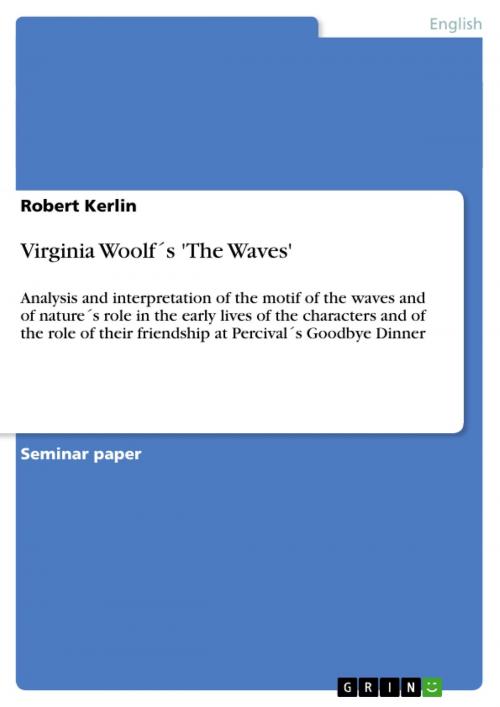Virginia Woolf´s 'The Waves'
Analysis and interpretation of the motif of the waves and of nature´s role in the early lives of the characters and of the role of their friendship at Percival´s Goodbye Dinner
Fiction & Literature, Literary Theory & Criticism, British| Author: | Robert Kerlin | ISBN: | 9783640502967 |
| Publisher: | GRIN Publishing | Publication: | January 5, 2010 |
| Imprint: | GRIN Publishing | Language: | English |
| Author: | Robert Kerlin |
| ISBN: | 9783640502967 |
| Publisher: | GRIN Publishing |
| Publication: | January 5, 2010 |
| Imprint: | GRIN Publishing |
| Language: | English |
Seminar paper from the year 2007 in the subject English Language and Literature Studies - Literature, grade: 2, University of Bamberg (Lehrstuhl für Englische Literaturwissenschaft), course: Virginia Woolf, language: English, abstract: Originally, what later became The Waves was called The Moths. Virginia Woolf began writing it on July 2nd 1929 . It underwent drastic changes during the writing and revising processes, that lasted until the year 1931, when it was eventually published by The Hogarth Press- the Woolf´s own publishing house. The Waves certainly and rightfully is regarded as Virginia Woolf´s most abstract and experimental, therefore least accessible novel. The 'story' is told through 'dramatic soliloquies' spoken by the six characters Rhoda, Jinny, Bernard, Susan, Neville and Louis. There is no real, direct interaction and talks between these characters, but they mean a lot to each other and bond from their common childhood onwards. A seventh character, Percival, is introduced to the reader by the monologues of the six, he never speaks for himself ,though. The whole plot is enclosed in a scene, that can be found daily all around the world: a sunrise over the ocean and the nearby beach, as well as a garden/nature scenery. Each of these interposed chapters symbolizes a stage of life the protagonists are now at and the developments they face. The main questions I will ask and set out to answer are what the theme of waves and water are supposed to symbolize and what role nature ,ubiquitous in this novel, plays and signifies for the respective characters during their childhood. These questions appear to be central for the understanding of this piece of writing, as they do not occur in any of Woolfe´s other works I have read so far.I will also try to analyze the importance of the friends the characters have made and their feelings during the farewell dinner for Percival. Firstly, I will give a general overview about the way the novel is conceived. Secondly, I will present the main characters and their general characteristics and then give the plot of the novel. After that, I will examine the role of the waves and the beach scenery in the novel and what nature means to the individual characters and their lives. Eventually, the focus will lie on what the reunion on the occasion of Percival´s imminent departure , set years after their last encounter, means to the characters and whether time and distance have alienated them from each other and nature. I will achieve these goals by the technique of 'close reading', ie. the approach to this study will mainly be text-based and contrastive.
Seminar paper from the year 2007 in the subject English Language and Literature Studies - Literature, grade: 2, University of Bamberg (Lehrstuhl für Englische Literaturwissenschaft), course: Virginia Woolf, language: English, abstract: Originally, what later became The Waves was called The Moths. Virginia Woolf began writing it on July 2nd 1929 . It underwent drastic changes during the writing and revising processes, that lasted until the year 1931, when it was eventually published by The Hogarth Press- the Woolf´s own publishing house. The Waves certainly and rightfully is regarded as Virginia Woolf´s most abstract and experimental, therefore least accessible novel. The 'story' is told through 'dramatic soliloquies' spoken by the six characters Rhoda, Jinny, Bernard, Susan, Neville and Louis. There is no real, direct interaction and talks between these characters, but they mean a lot to each other and bond from their common childhood onwards. A seventh character, Percival, is introduced to the reader by the monologues of the six, he never speaks for himself ,though. The whole plot is enclosed in a scene, that can be found daily all around the world: a sunrise over the ocean and the nearby beach, as well as a garden/nature scenery. Each of these interposed chapters symbolizes a stage of life the protagonists are now at and the developments they face. The main questions I will ask and set out to answer are what the theme of waves and water are supposed to symbolize and what role nature ,ubiquitous in this novel, plays and signifies for the respective characters during their childhood. These questions appear to be central for the understanding of this piece of writing, as they do not occur in any of Woolfe´s other works I have read so far.I will also try to analyze the importance of the friends the characters have made and their feelings during the farewell dinner for Percival. Firstly, I will give a general overview about the way the novel is conceived. Secondly, I will present the main characters and their general characteristics and then give the plot of the novel. After that, I will examine the role of the waves and the beach scenery in the novel and what nature means to the individual characters and their lives. Eventually, the focus will lie on what the reunion on the occasion of Percival´s imminent departure , set years after their last encounter, means to the characters and whether time and distance have alienated them from each other and nature. I will achieve these goals by the technique of 'close reading', ie. the approach to this study will mainly be text-based and contrastive.















